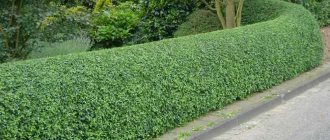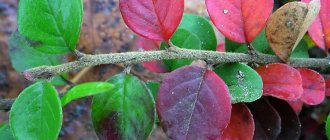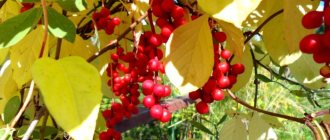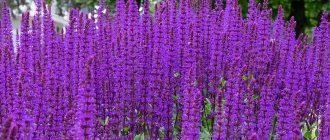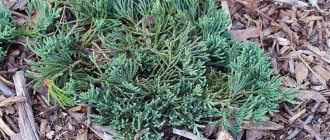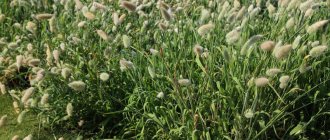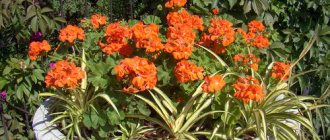Many gardeners, in search of a beautiful and unpretentious plant, get acquainted with a variety of crops. One of them is the horizontal cotoneaster. This garden planting provides many options for landscaping. Outwardly, this representative of the flora is unprepossessing; it does not have bright leaves or exotic flowers, but this does not diminish its popularity. Creeping species are especially in demand and are used to decorate slopes or slides.
Most varieties, like horizontal cotoneaster, are excellent for the suburban area of always busy owners. The plant does not require special care, is not afraid of frost and does not take up too much time . The evergreen plant reaches up to 50 cm, dense shoots look like the backbone of a fish. The leaves are small, round in shape, no more than 1.5 cm in diameter. In autumn, their color turns from dark green to crimson. Flowering begins in late spring and decorates the landscape with small pink flowers, with a small splash of red. At the beginning of autumn, small bright red fruits appear. The fruiting period continues until winter, and in some species until spring.
Description
Photo:
Cotoneaster horizontalis is a lush shrub from the Rosaceae family. Wild specimens of this plant are found in China. This is an evergreen perennial shrub that does not lose its “clothes” for the winter.
The shoots, as the name suggests, grow horizontally and spread along the ground. The plant does not grow higher than 1 meter in height.
At the same time, it grows up to 2 meters in width. Such shoots perfectly camouflage unsightly and rocky areas of the ground.
The shoots of horizontal cotoneaster are most often located in one plane and have the shape of a fish ridge with one large branch and symmetrically arranged shoots.
The leaves of the bush are small - up to 1.5 cm in diameter. The surface is smooth and shiny. In autumn, the foliage on the shrub changes its color to red or crimson.
Cotoneaster blooms in early May, and the flowering process lasts 3 weeks. The flowers do not have a bright attractive color and are usually light pink.
The fruits from the ornamental shrub are inedible because they do not have a distinct taste. But at the same time, they are not poisonous, so if there are children in the family, decorating the area with cotoneaster is a safe option.
The shrub does not need to be covered, as it tolerates frost easily. This is an excellent decorative solution for the northern regions of the country.
As for diseases and pests, cotoneaster most often suffers from fusarium. This is due to the fact that the plant does not tolerate high humidity, and the fungus starts quickly.
Affected shoots must be cut off and destroyed. The most common pests that are dangerous to shrubs are aphids and spider mites. In this case, it is enough to treat the bush with a good insecticide.
Features of cultivation
Cotoneaster is unpretentious in care. The only thing this shrub is picky about is the soil.
The most acceptable composition would be:
- Sand.
- Peat compost.
- Turf.
- Humus (as fertilizer). Add as desired.
The mixture proportion is 2:1:2. It is recommended to add no more than 300 g of lime per 1 m² when planting. When planting a large number of plants, you need to take into account their crown in the future. The minimum distance between bushes is 0.5-2 m.
The plant is immune to drought. It should be watered once a month. If the weather is hot in summer, then select the mode once every 2 weeks. The plant needs to be prepared for wintering. To do this, the ground around the bush is mulched with peat. Before this, its lower branches are bent to the ground.
Top dressing
Horizontal cotoneaster (photos and descriptions of care are provided by nurseries when purchasing seedlings) are fertilized with the onset of warm days in spring. Before flowering begins, the plant is fed. As an additive, you can use 25 g of urea dissolved in 10 liters of water. After this, the bush is watered at the root.
You can also use Fertika Universal - 2 fertilizer. Its composition contains complex minerals. The composition of the product is granular and does not contain chlorine. Fertilizer has a prolonged effect. You must first prepare the soil. Fertilizer is scattered over the surface of the earth and then dug up. The granules should be evenly distributed in the substrate.
When they begin to dissolve in the soil, the bush receives nutrition. Fertilizer is used throughout the growing season. Also, this method is good to use when the soil is depleted and needs to be enriched with nutrients. At the end of May, you can feed the plant with superphosphate. 60 g of substance is used per 1 m².
An alternative is 15 g of potassium sulfur for the same volume of soil.
Trimming
Horizontal cotoneaster grows very quickly. Because of this circumstance, the bush must be pruned regularly. It is very easy to form a cotoneaster crown - it lends itself well to manipulation, and therefore it is good to use for the garden. The bush can be given a shape and a suitable size. Also, this species can be grown using the standard method.
Trim the plant before buds appear in the spring. One-year-old shoots are cut off at ¼ height. In subsequent years, only 1/3 of the branch must be removed. Thanks to this, they begin to bush more actively. Also, it would not be superfluous to sanitize the bush. All damaged and dead branches must be removed.
How to propagate
Only an adult plant can be propagated. When growing shrubs, you need to pay attention to creeping layering. They may produce roots. They can just be used to propagate shrubs on the site. In addition, cotoneaster is propagated by cuttings.
Do I need to cover it for the winter?
Horizontal cotoneaster (photos and descriptions of the variety can be found in foreign sources under the name cotoneaster atropurpureus) has good winter hardiness. It is ideal for growing in central Russia.
However, during periods of heavy frost, damage appears on the bush caused by high negative air temperatures. Young shrubs should be protected from cold air in the first years after planting. Therefore, the shoots of the plant are covered for the winter.
To do this, you can use natural or purchased materials:
- Mulching mixture. You can make it yourself or purchase a ready-made version at a garden center.
- Coniferous branches. The entire bush is covered with spruce branches.
- Lutrasil. A man-made fiber that is sold in different densities. You can cover it like a plant or a structure above it.
- Craft paper. The material protects shoots well from frost due to its high density.
It is worth considering that adult plants are covered only in case of long frosts. During periods when the air temperature drops below -35°C.
Varieties
Before planting horizontal cotoneaster, you need to select a variety.
Popular varieties of cotoneaster, which are most often used when planting for decorative purposes:
Variegatus
This is a creeping plant, reaching a height of up to 30 cm. The main feature is that it is an evergreen shrub only in warm and temperate latitudes, and in cold climates it turns into a deciduous plant.
Perpusillis
A variety characterized by slow shoot growth. The plant grows up to 50 cm in height. The leaves are dense and fleshy. Fruits in late August, blooms in late May.
The shrub is distinguished by its elegance and will decorate any area, especially in the fall, when it will stand out as a crimson spot against the background of conifers and evergreens.
These are the most popular varieties that are often found in decorative areas and decorate areas, create hedges, and evergreen sculptures.
Horizontal cotoneaster looks just as impressive in the photo as it does on the site itself.
Varietal diversity
Common cotoneasterVariegatus
Horizontal cotoneaster and its varieties are very popular among gardeners because of their discreet decorative effect, which can decorate the garden at any time of the year. The most famous varieties:
- variegatus _ Its feature is the white border that frames the leaves;
- perpusilus . This is the fastest growing variety among all the others;
- sahatilis . Very small leaves are located on lying branches.
Landing
With proper planting and quality care, the plant will decorate the area for a long time and delight the owner with its smooth leaves.
It is important to choose the right soil and place for planting, and then carry out simple care.
Site selection and soil preparation
Horizontal cotoneaster differs from its related varieties in that it is picky about the soil in which it grows.
It needs to have a fertile and nutritious environment for normal development.
The soil must necessarily contain sand, peat and soil. The area must be dug up and leveled before planting.
Important! When choosing a location, first of all you need to pay attention to the lighting. Cotoneaster prefers bright places, perhaps with some partial shade.
It is desirable that the groundwater lies deep, and it is ideal that the bush itself is located on a small hill. Cotoneaster also feels great on the slopes.
Landing rules
The algorithm for planting cotoneaster is not complicated. First you need to prepare a hole with a drainage system. The thickness of the broken brick drainage layer is 20 cm.
In addition to broken bricks, pebbles are excellent for drainage. The depth of the hole is 70 cm and the width is up to 50 cm. More precise parameters of the hole depend on the size of the root system.
Seedlings with a closed root system should not be freed from the ground. Shaking off clods of soil may cause damage. This way it will be easier to dig in.
In this case, the root collar should be flush with the ground. After planting, the seedling should be watered abundantly.
Portrait of a plant
Cotoneaster (Cotoneaster) is part of the genus of the same name in the Rosaceae family. In total, there are more than 80 species in this genus, which are represented by deciduous or evergreen shrubs of varying heights (from 0.3 to 3-5 meters). More than 40 species of this plant are found in our country.
A large number of simple leaves of a dense green color, located alternately (one after another) on the branches, almost completely cover the bushes. They are attached to the shoots with short petioles. As the autumn months approach, the leaves turn red.
Cotoneaster flowers are pinkish or white, solitary or united in small inflorescences such as a multi-flowered raceme or corymb. Spherical shiny fruits of red or black color with several seeds inside stay on the bushes until late autumn. They give the bushes a spectacular appearance that lasts for a long time.
How is cotoneaster planted? What kind of care does he need? What subtleties of growing cotoneaster do you need to know? Read more about this.
Care
Shrub care is also easy. First of all, you should remember that horizontal cotoneaster does not tolerate excess water, but prefers drought.
Therefore, even if the summer was rainless, watering the bush once a week or two is enough.
When there is rain, the amount of watering is reduced. When watering, you cannot pour more than 5 buckets of water under one bush. If the soil is wet, then this indicator should be reduced.
After watering, be sure to loosen the soil and weed, removing all weeds. As a spring fertilizer, a urea solution is applied under the bush.
Before flowering begins, superphosphate or potassium fertilizers must be applied to the bush.
In addition, pruning is required in the care. This helps to form a hedge or give the bush the desired shape.
Cotoneaster in winter
Autumn
Almost all types of cotoneaster are distinguished by their frost resistance and can easily survive the winter without insulation. However, the tree trunk circle must be sprinkled with a layer of mulch (peat). If there is a threat of freezing of the cotoneaster, it is recommended to bend it to the soil surface and fix it in this position. Then the bush must be covered with dried leaves.
Wintering
If little snow or too frosty winter is expected, then the bush can be additionally insulated with covering material or spruce branches. If a large amount of snow falls, it is recommended to remove the shelter. The bushes will need to be covered with a layer of snow. In the middle zone, the most popular cotoneasters are whole-edged, black-fruited and shiny. These species are characterized by very high winter hardiness and can withstand severe frosts without insulation.
Reproduction
Horizontal cotoneaster reproduces in several ways.
The shrub can be propagated by growing seeds, as well as by cuttings and layering.
When propagating by seeds, the shrub will have to be grafted; most often, cotoneaster is grafted onto hawthorn or rowan.
Cuttings
For propagation you will need cuttings. Healthy shoots that remain after pruning can be used as cuttings.
The shoots should be prepared by cutting them at an angle and then placed in a growth stimulator for a day. The cuttings must have several buds and not show signs of damage by various diseases.
When the day has passed, the cuttings can be planted on the site in loosened and fertilized soil, which was specially prepared for them. After planting, all cuttings are covered with a plastic jar or bottle.
The optimal time for planting and rooting cuttings is June. In this case, next spring the cuttings will become full-fledged plants.
Horizontal cotoneaster propagates quite well from cuttings; this is the most common propagation method.
Growing from seeds
Growing a full-fledged cotoneaster bush from seeds is quite troublesome, but the owner will be pleased with the results.
The algorithm is simple:
- Collect fruits in October and November.
- Remove the pulp from the seeds, rinse and dry.
- Soak in water, and all floating seeds are removed as defective.
- Mix the seeds with peat and sand.
- Moisten the mixture.
- Place in boxes in a layer of 30–40 cm.
- The seeds should be deepened by 0.7 cm.
- Keep the box until spring at a temperature close to zero degrees.
- The germination rate of cotoneaster is from 5 to 20%.
- During the germination period, the seeds should be watered, making sure that the seeds are not exposed. If the seeds appear on the surface, deepen them again to the required depth.
- In spring you can plant seeds. Seedlings can be placed in open ground after the first 2 leaves have appeared on them.
Important! Experts do not recommend growing horizontal cotoneaster from seeds. Only half comes up. The other two methods are much more effective.
By layering
The horizontal location of cotoneaster allows for easy propagation by layering. To do this, just press the shoots to the ground and pin them with staples.
The place where the shoot is pressed should be covered with humus and peat. In the spring, you should cut off the main bush from the pinned layer and transplant the seedling to a permanent place.
In landscape design
In gardening, the horizontal cotoneaster is highly valued as an ornamental plant.
These are most often hedges and various structures.
You can also often use small varieties in the form of border structures that decorate garden paths.
In group plantings, the dogwood bush goes well with various coniferous plants.
It is used in landscaping park areas, as well as sidewalks and recreation areas around the world. If you use cotoneaster in rock gardens, then choose the middle tier for it.
It also looks great against the background of stones and rocky hills, and therefore is used in various combinations.
Diseases and pests
Fusarium
most often interferes with development of aphids and moths . You can notice the appearance of the pest by the leaves curling and beginning to dry out. You can fight them with the help of organophosphorus pesticides (for example, “karbofos”).
As a preventative measure, it is recommended to use fungicides by spraying, for example, with nitrophen.
Among the diseases that affect the plant, the most common is fusarium . This is a very dangerous fungal disease, which, unfortunately, has no cure.
In case of disease, all infected parts of the plant should be cut off and burned. In case of a large spread of infection, the bush is transplanted to a new place or destroyed, and the soil is thoroughly disinfected.
Life cycle and development nuances
Cotoneaster can live a fairly long life - 50 years, provided it is well cared for. Since this plant is completely undemanding, this is quite possible.
The bush grows very quickly and requires pruning to form a crown. Thanks to the horizontal growth of the crown, this type of cotoneaster acquired its name. The branches of the bush do not grow upward, but parallel to the ground.
